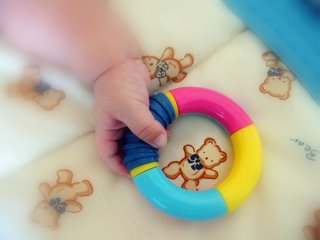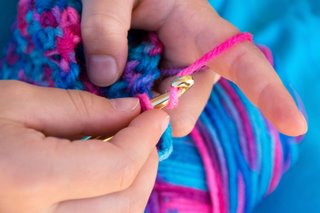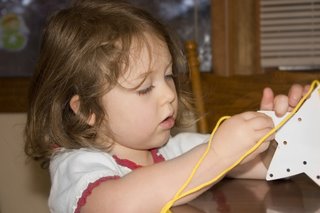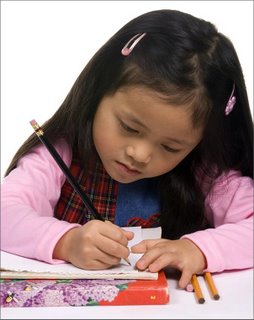We tend to throw around the phrase “fine motor skills” a lot without really thinking about what it means. What are fine motor skills? How are they best developed? To start, let’s define fine motor skills as commonly used in educational circles:
Fine motor skills are coordinated small muscle movements in the hands, wrists, and fingers. Often, the eyes are used to guide the movements.
The Sequence of Fine Motor Skill Acquisition
 Babies start their fine motor development almost right away, with reflexes that let them grasp an adult’s finger or a rattle that you give to them. Around the age of two, kids are really ready to start fine motor activities in earnest. At this point, they may be as simple as learning to turn a doorknob, pick up a knobbed puzzle piece, or draw on a piece of paper with a chunky crayon. The two-year-old child will also need many large motor activities that use the big muscles of the arms and legs. These can include things like scrubbing, painting on large paper, hopping, and walking on the line.
Babies start their fine motor development almost right away, with reflexes that let them grasp an adult’s finger or a rattle that you give to them. Around the age of two, kids are really ready to start fine motor activities in earnest. At this point, they may be as simple as learning to turn a doorknob, pick up a knobbed puzzle piece, or draw on a piece of paper with a chunky crayon. The two-year-old child will also need many large motor activities that use the big muscles of the arms and legs. These can include things like scrubbing, painting on large paper, hopping, and walking on the line.
As children grow and develop, they are able to do more complicated tasks. They may be able to zip a zipper and use a spoon and fork. A three-year-old child will be frequently using the medium-sized muscles of the hand to pour, mix, and sweep.
 By the age of four, a child will truly be ready to use the small muscles of the fingers. The child may be drawn to lacing beads and cards, rolling pins and cookie cutters, drawing with colored pencils, and puzzles with small knobs. The refinement of these small muscles will continue on into the elementary years, as tasks like slicing, sewing, and handwriting become accessible.
By the age of four, a child will truly be ready to use the small muscles of the fingers. The child may be drawn to lacing beads and cards, rolling pins and cookie cutters, drawing with colored pencils, and puzzles with small knobs. The refinement of these small muscles will continue on into the elementary years, as tasks like slicing, sewing, and handwriting become accessible.
What Really Needs to Be Learned?
There are four specific kinds of fine motor movements that need to be mastered in order for a child to take part in the tasks of daily life:
- Grasping – A child grasping a rattle is the most basic use of this skill. Over time, it will be refined into a pincer grip that enables the use of tweezers or writing with a pencil
- Reaching – Being able to extend the arm, wrist, and hand so that an object can be picked up
- Releasing an Object – Letting go of an object at a specific time or putting it in a specific place
- Turning the Wrist – Being able to twist an object like a doorknob or screwdriver, or remove a lid from a jar
Taken together, these movements enable everything from bead stringing to knitting to calligraphy. The skills often develop simultaneously, since many times more than one is used in the same activity. Each skill may take some time to be perfected. Sometimes we forget how much time – and repetition – is needed to master these important abilities. It’s important to give kids plenty of time to work on these skills, and lots of activities that encourage them to do so.
 Some children may face different challenges in learning fine motor skills. Low muscle tone, poor coordination, or impaired vision will make learning these skills difficult. Left-handed kids may find certain right-handed tasks (like can openers) to be a challenge. At each stage of development, though, there is usually something that the child is capable of. Even if that’s just kneading play-doh or stacking blocks, it’s a beginning. By changing the nature of the material (adding a rolling pin; making the blocks smaller), the difficulty of the task can be changed incrementally over time.
Some children may face different challenges in learning fine motor skills. Low muscle tone, poor coordination, or impaired vision will make learning these skills difficult. Left-handed kids may find certain right-handed tasks (like can openers) to be a challenge. At each stage of development, though, there is usually something that the child is capable of. Even if that’s just kneading play-doh or stacking blocks, it’s a beginning. By changing the nature of the material (adding a rolling pin; making the blocks smaller), the difficulty of the task can be changed incrementally over time.
Montessori Materials Are Fine Motor Skill Blockbusters
Let’s look at a few common Montessori materials and see which of the four skills they’re encouraging. In many cases, the material may require more than one of the skills. You may not have realized that fine motor skills are being required of children all the time in the Montessori environment!
- Knobbed Cylinder Blocks: These are a very obvious use of the grasping skill, but can also involve the other three: the child may need to reach to pick up the cylinder, then release it and possible turn the wrist to get it to fit.
- Golden Beads & Bead Stairs: Those tiny golden beads are sure great for that pincer grip! If you need to put the beads in a specific place, like with the hanging bead stair, releasing and turning the wrist become important too.
- Polishing: This is a wonderful way for kids to practice turning the wrist, especially if they are cleaning something round like a bowl or large spoon.
- Metal Insets: These tracing insets required kids to not only hold a pencil firmly and correctly, but move the arm and wrist in order to trace them. Older children may find it challenging to make intricate designs with the insets, further refining their pincer grip long after they’ve learned to write.
- The Pink Tower: The pink tower is sort of an all-around motor skills champion. The smallest cube should be grasped by the thumb and forefinger in a perfect pincer grip. A child will need to reach for the cubes and set them down deliberately and in the right place. Moving the cubes to the rug engages the large motor muscles of the legs.
- Rolling and Unrolling a Rug: This isn’t a Montessori material per se, but it’s the perfect place for little fingers to practice grasping and reaching without even realizing it. It also engages larger muscles in the arms and legs, and requires some critical thinking as the child finds the perfect place to put it (not too close to other kids or the shelves). And they must visualize how much room it’s going to take up once unrolled, engaging their spatial reasoning. Not bad for what looks like a simple preface to the “real” work.
A Lifetime Pursuit
 I don’t know if anyone can ever say they’ve mastered fine motor skills completely. There’s always something new to learn – woodworking, needlepoint, oil painting. The list of tasks requiring our fine motor muscles is truly endless. Montessori kids have a definite head start because they are engaging those skills every day in a multitude of ways. Keep an eye out, and you will see fine motor activities everywhere!
I don’t know if anyone can ever say they’ve mastered fine motor skills completely. There’s always something new to learn – woodworking, needlepoint, oil painting. The list of tasks requiring our fine motor muscles is truly endless. Montessori kids have a definite head start because they are engaging those skills every day in a multitude of ways. Keep an eye out, and you will see fine motor activities everywhere!

